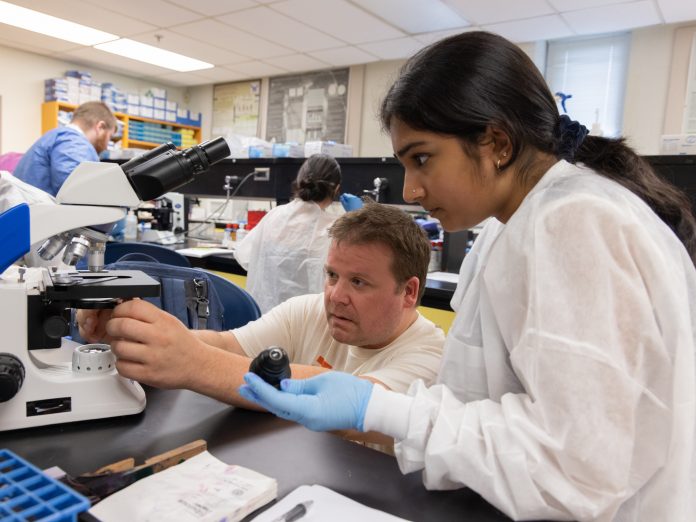As an early-career social worker, Catherine Corto-Mergins, DSW ’25, helped people who had lost someone to homicide.
“Looking back, it was one of the most profound experiences, and I found myself wondering if anything had changed in terms of available support,” says Corto-Mergins, now the director of training for The Village. The Village, with a staff of 600, provides support services in the Greater Hartford region. Decades later, as a doctoral student at Southern, Corto-Mergins finally had the opportunity to find out.

Her research revealed that not much had changed unfortunately — and highlighted the importance of homicide-specific, trauma-informed care. “For example, homicide-related trauma often has a specific focus on anger,” she says.
On May 5, she was one of about 175 students who presented their findings at Southern’s Graduate Student Research and Creative Activity Conference — one of many university-wide events that showcase student-led research. Two days earlier, undergraduates had taken the stage for their own research conference.
And it doesn’t stop there: Southern has an entire Division of Research and Innovation, with a mission of “facilitating and celebrating innovative research, scholarship, and creative activities.”
There are research programs for first-year students as well as frequent opportunities to present at department events and state, regional, and national conferences.
“Research is not just an activity — it is a mindset,” says Julia Irwin, interim provost and professor of psychology. “Students at Southern gain hands-on experiential learning in diverse fields, guided by faculty deeply committed to research and teaching. Direct collaboration with experts on student-driven projects enhances learning, making it one of the most effective teaching tools and among our greatest assets here at Southern.”
As Kate Vitasek, senior contributor for Forbes, notes in an article published June 13: “Mastering academic research, learning to ask the right questions, analyzing information, and generating actionable insights are becoming increasingly crucial.”


Connecticut’s First and Only R2
Southern’s commitment to faculty-student collaborative research sets it apart and that distinction was formally recognized in 2025 when the institution became Connecticut’s first and only Carnegie-designated Research 2 university. The Carnegie Classification framework is the nation’s leading system for categorizing research activity in higher education. Only 139 institutions nationwide hold the R2 designation, placing Southern in elite company. (Only Yale and the University of Connecticut are ranked higher in the state, as R1 institutions.)
AS A REGIONAL, PUBLIC UNIVERSITY Southern also can provide undergraduate students with opportunities to pursue graduate-level research.
“We offer the kinds of research experiences here that you could get at UConn or Yale, but we do that in a small department environment with personalized attention,” says Elliott Horch, chairman of the Department of Physics. (Here’s more on the world-class research being conducted by his students.)



To qualify as R2 — meaning high research spending and doctorate production — a university must award at least 20 research doctorates yearly and spend $5 million annually on research. In fiscal year 2023, Southern exceeded both benchmarks, awarding 29 doctorates and totaling $8,007,000 in research expenditures.
A significant portion of Southern’s research and development expenses come from institutional investments, but research is also supported by federal agencies such as the National Science Foundation, the National Institutes of Health, and the departments of Defense, Agriculture, Energy, and Education.
As these varied collaborations would suggest, research at Southern spans disciplines — benefiting campus and the community-at-large. The university is home to numerous Centers of Excellence that promote scholarship and real-world applications. These include:
• Center of Excellence on Autism Spectrum Disorders
• Center for Educational and Assistive Technology
• CSCU Center for Nanotechnology (CNT)
• Center for Research on Interface Structures and Phenomena (CRISP)
• The Werth Center for Coastal and Marine Studies
• Center for Excellence in Mathematics and the Sciences
• Research Center on Values in Emerging Science and Technology
• SCSU Center for Excellence in Teaching and Learning

For many students, these centers are a gateway to research experience. For example, the Werth Endowed Industry Academic Fellowship (IAF) program, funded by the Werth Family Foundation and housed in the CNT, provides team-based research in nano and quantum technologies. It’s just one of numerous programs offering student stipends, in this case, up to $5,000 for the summer.
Research Leads to Buley Library


Buley Library is a cornerstone of student research, offering a wealth of resources — from expert guidance to conference poster printing. As the academic hub of campus, Buley maintains access to more than 100 databases and electronic collections. It also houses over half a million items, including books, maps, government documents, rare books, video media, and more. About a dozen subject librarians provide specialized support across 40 academic disciplines, ranging from accounting to world languages and literatures.
From physics and education to business and social work, students are asking critical questions — and learning to find the answers. Among those featured: two transfer students turned astronomers, a team teaching Chinese to high schoolers through a National Security Agency–funded program, and a business student from Germany studying the appeal of green bonds. Together, they reflect what sets Southern apart: a commitment to hands-on, student-driven research that prepares learners to tackle real-world challenges — here in Connecticut and beyond.
Read more from Southern Alumni Magazine



